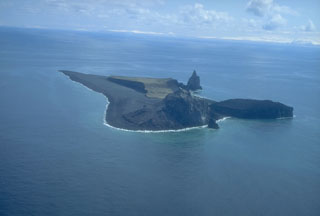Report on Bogoslof (United States) — 18 October-24 October 2023
Smithsonian Institution / US Geological Survey
Weekly Volcanic Activity Report, 18 October-24 October 2023
Managing Editor: Sally Sennert.
Please cite this report as:
Global Volcanism Program, 2023. Report on Bogoslof (United States) (Sennert, S, ed.). Weekly Volcanic Activity Report, 18 October-24 October 2023. Smithsonian Institution and US Geological Survey.
Bogoslof
United States
53.93°N, 168.03°W; summit elev. 150 m
All times are local (unless otherwise noted)
AVO raised the Volcano Alert Level for Bogoslof to Advisory (the second level on a four-level scale) and the Aviation Color Code to Yellow (the second color on a four-color scale) on 24 October due to increased seismicity. Over 90 earthquakes were detected in the vicinity of the volcano during the previous three days. No signs of unrest had been recorded in satellite data over the past several days.
Geological Summary. Bogoslof is the emergent summit of a submarine volcano that lies 40 km N of the main Aleutian arc. It rises 1,500 m above the Bering Sea floor. Repeated construction and destruction of lava domes at different locations during historical time has greatly modified the appearance of this "Jack-in-the-Box" volcano and has introduced a confusing nomenclature applied during frequent visits by exploring expeditions. The present triangular-shaped, 0.75 x 2 km island consists of remnants of lava domes emplaced from 1796 to 1992. Castle Rock (Old Bogoslof) is a steep-sided pinnacle that is a remnant of a spine from the 1796 eruption. The small Fire Island (New Bogoslof), about 600 m NW of Bogoslof Island, is a remnant of a lava dome formed in 1883.
Source: US Geological Survey Alaska Volcano Observatory (AVO)

